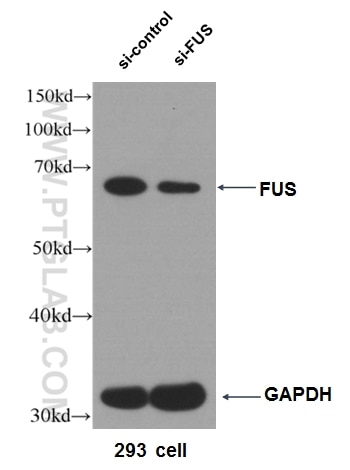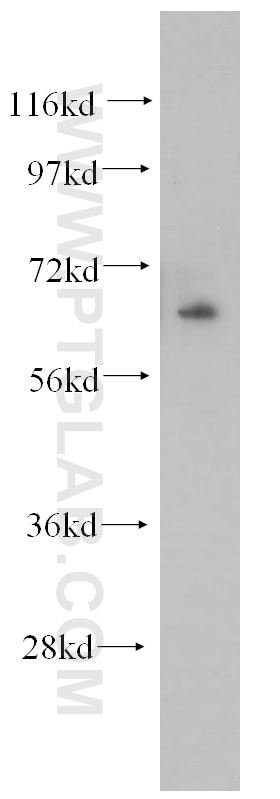- Phare
- Validé par KD/KO
Anticorps Polyclonal de lapin anti-CREB3L1,OASIS
CREB3L1,OASIS Polyclonal Antibody for WB, IF, IHC, ELISA
Hôte / Isotype
Lapin / IgG
Réactivité testée
Humain, rat, souris
Applications
WB, IHC, IF/ICC, ELISA
Conjugaison
Non conjugué
N° de cat : 11235-2-AP
Synonymes
Galerie de données de validation
Applications testées
| Résultats positifs en WB | cellules A549, cellules COLO 320 |
| Résultats positifs en IHC | tissu de cancer de la prostate humain il est suggéré de démasquer l'antigène avec un tampon de TE buffer pH 9.0; (*) À défaut, 'le démasquage de l'antigène peut être 'effectué avec un tampon citrate pH 6,0. |
| Résultats positifs en IF/ICC | cellules A549 |
Dilution recommandée
| Application | Dilution |
|---|---|
| Western Blot (WB) | WB : 1:500-1:1000 |
| Immunohistochimie (IHC) | IHC : 1:20-1:200 |
| Immunofluorescence (IF)/ICC | IF/ICC : 1:50-1:500 |
| It is recommended that this reagent should be titrated in each testing system to obtain optimal results. | |
| Sample-dependent, check data in validation data gallery | |
Applications publiées
| KD/KO | See 1 publications below |
| WB | See 8 publications below |
| IHC | See 4 publications below |
Informations sur le produit
11235-2-AP cible CREB3L1,OASIS dans les applications de WB, IHC, IF/ICC, ELISA et montre une réactivité avec des échantillons Humain, rat, souris
| Réactivité | Humain, rat, souris |
| Réactivité citée | rat, Humain |
| Hôte / Isotype | Lapin / IgG |
| Clonalité | Polyclonal |
| Type | Anticorps |
| Immunogène | CREB3L1,OASIS Protéine recombinante Ag1757 |
| Nom complet | cAMP responsive element binding protein 3-like 1 |
| Masse moléculaire calculée | 57 kDa |
| Poids moléculaire observé | 55-58 kDa and 84 kDa |
| Numéro d’acquisition GenBank | BC015781 |
| Symbole du gène | CREB3L1/OASIS |
| Identification du gène (NCBI) | 90993 |
| Conjugaison | Non conjugué |
| Forme | Liquide |
| Méthode de purification | Purification par affinité contre l'antigène |
| Tampon de stockage | PBS avec azoture de sodium à 0,02 % et glycérol à 50 % pH 7,3 |
| Conditions de stockage | Stocker à -20°C. Stable pendant un an après l'expédition. L'aliquotage n'est pas nécessaire pour le stockage à -20oC Les 20ul contiennent 0,1% de BSA. |
Informations générales
Cyclic AMP-responsive element-binding protein 3-like protein 1(CREB3L1) belongs to a family of transcription factors that are synthesized as membrane-bound precursors in the endoplasmic reticulum (ER) and then transported to the Golgi where they are activated through regulated intramembrane proteolysis (RIP). Also it participates in ER-stress response in astrocytes in the central nervous system. It may has a role in gliosis, and involves in activation of transcription through box-B element but not CRE. CREB3L1 acts as a transcription repressor in proliferation of virus-infected cell. The full-length precursor form (approximately 84 kDa) of CREB3L1 and the matured form of CREB3L1 is 58 kDa. (PMID: 20668028)
Protocole
| Product Specific Protocols | |
|---|---|
| WB protocol for CREB3L1,OASIS antibody 11235-2-AP | Download protocol |
| IHC protocol for CREB3L1,OASIS antibody 11235-2-AP | Download protocol |
| IF protocol for CREB3L1,OASIS antibody 11235-2-AP | Download protocol |
| Standard Protocols | |
|---|---|
| Click here to view our Standard Protocols |
Publications
| Species | Application | Title |
|---|---|---|
Epigenetics OASIS/CREB3L1 is epigenetically silenced in human bladder cancer facilitating tumor cell spreading and migration in vitro. | ||
Endocrinology OASIS/CREB3L1 induces expression of genes involved in extracellular matrix production but not classical endoplasmic reticulum stress response genes in pancreatic beta-cells. | ||
Breast Cancer Res Epigenetic silencing of CREB3L1 by DNA methylation is associated with high-grade metastatic breast cancers with poor prognosis and is prevalent in triple negative breast cancers. | ||
PLoS One OASIS/CREB3L1 is induced by endoplasmic reticulum stress in human glioma cell lines and contributes to the unfolded protein response, extracellular matrix production and cell migration.
| ||
BMC Cancer CREB3L1 as a potential biomarker predicting response of triple negative breast cancer to doxorubicin-based chemotherapy. | ||
Front Endocrinol (Lausanne) Maternal Protein Restriction Induces Alterations in Hepatic Unfolded Protein Response-Related Molecules in Adult Rat Offspring. |












